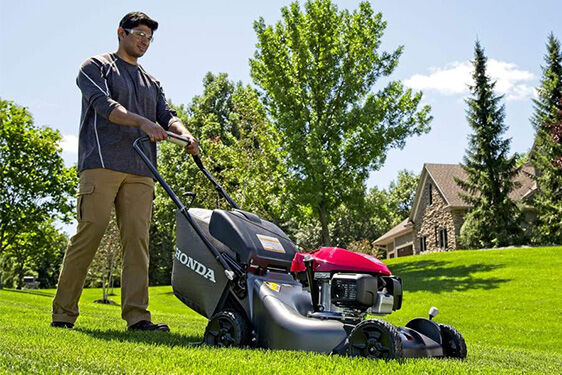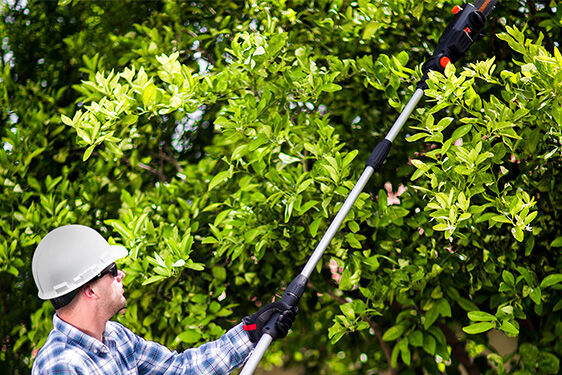As the weather gets warmer, our must-have outdoor tools emerge from winter storage. Whether you’re a landscaper or homeowner, being able to work outside regularly again is (quite literally) a breath of fresh air. This is also a great moment to take stock of your current collection of outdoor tools and determine if they’re still meeting your needs.
When working outdoors, maneuverability and convenience are two of the biggest factors. Just about all of us have likely become frustrated with a corded tool at some point when untangling a mass of cables, tripping over a cord, or struggling to reach an outlet. Maybe you even accidentally cut a power cord with your chainsaw.
Many of the most important outdoor tools are now available in cordless models, including mowers, blowers, chainsaws, pole saws, string trimmers, and hedge trimmers. Still on the fence? We’ll provide a closer look at why now is the right time to make the switch to cordless
Why Should I Use Cordless Outdoor Tools?
Even just a few years ago, you would have probably chuckled at the idea of cordless tools becoming your go-to options for outdoor projects. They simply didn’t offer the same level of power and performance as their corded counterparts, which made a big difference in heavy-duty tasks like cutting through thick tree branches. You also needed to closely monitor the battery level and may have had to stop working to recharge or swap to your backup.
The corded vs. cordless debate has been evolving rapidly, and many of the traditional drawbacks of cordless power tools are no longer the deal-breakers they once were for many users. The power and runtime delivered by cordless tools have taken a massive leap forward in recent years thanks to significant improvements in technology. With the latest lithium-ion batteries and brushless motors, power tools can run longer and handle more strenuous jobs than ever before. When you factor in their other benefits, today’s cordless tools are even more appealing.
• Cordless tools are more compact and lightweight than corded models, making them easier and more comfortable to use for extended periods of time.
• Even the best corded tools will suffer from the most obvious downside of having movement restricted by the length of your cord and the availability of an outlet. In yards and other outdoors areas where space may be limited (or otherwise challenging), this is a big win for cordless tools.
• Moving away from gas-powered tools is also a major advantage from both a convenience and health standpoint. Cordless tools are more environmentally friendly since they eliminate the need for exhaust, and who wouldn’t be happy about not breathing in those fumes again? You may have tolerated gas-powered chainsaws in the past because they were the only ones powerful enough to make quick work of those tough cutting tasks. Now, cordless models can virtually match corded ones in terms of power, giving you the best of both worlds.
• Gas-powered tools are also more difficult to maintain, and you’ll save plenty of hours by switching to cordless. You can spend less time buying fuel and making sure your saw or mower is filled up, and more time actually getting the job done.
All of the major tool brands - including DeWALT, Makita, Husqvarna, Milwaukee, Greenworks, Sun Joe, Simpson, Skill, Black & Decker, Snapper, to name a few - now offer full lines of outdoor cordless power tools, so it’s extremely easy to make the switch. Now that we’ve discussed the main reasons to go cord-free, let’s take a look at the outdoor power tools you’ll want to add or upgrade in your collection.
Key Power Tools for Outdoor Projects
From pruning trees and shrubs to mowing the lawn, there’s a lot to do outside. Having access to a wide range of tools ensures you’ll be prepared for anything the jobsite or your own yard can throw at you. There’s a good chance you’re already familiar with these items and own many, if not all of them. However, let’s review important features and distinctions to keep in mind that can improve your experience working on outdoor projects.
Lawnmowers
You know about the primary types of lawnmowers, namely walk-behind and riding mowers, but you’ll save yourself a lot of work by making sure you’re using the one that’s best for the area you’re mowing. This can be somewhat tricky if your yard or space is on the borderline between requiring a walk-behind or riding mower. As a general rule, it’s a good idea to use a walk-behind model if you’re mowing an area under a half-acre. Anything more and you’ll want to invest in a ride-on mower.
Mowers are one of the most recognizable outdoor tools, but they’re quickly entering the modern age with useful new features. Electric mowers now offer a stronger combination of power and dependability. You’ll appreciate not having to strain your shoulder by pulling or cranking to start it like you do with a gas-powered mower. There is also a growing selection of self-propelled mowers available that don’t even require you to push. If you’re especially tech-savvy, you may even consider a robotic mower that trims your lawn like a giant Roomba, though these models are still emerging.
- Rear vs Side Discharge: There are a variety of other features to consider as well when matching a mower to your needs. Depending on your mowing style, you may choose between a rear discharge or side discharge lawnmower. A side discharge model is appealing if you don’t want to bag and dispose of your lawn clippings. If you want to fertilize your lawn as you mow, look for a mulching lawnmower. These mowers also return vital nutrients to the soil, and they leave behind smaller clippings than side discharge models. This is good if you want to make sure your mower doesn’t eject blades of grass into flower beds or other areas.
- Cutting Width: You’ll also want to choose a mower with a cutting width that suits your space. A wider mower will save you time and effort when trimming a huge lawn, but it may prove too unwieldy for smaller yards. In general, a 20-inch cutting width is appropriate for most residential lawns, though you can also find walk-behind mowers that extend beyond 30 inches for even more coverage.
- Wheel Size: There are other features to keep in mind to make your mower easier to operate and better suited to the job at hand, including wheel size. Larger rear wheels (usually 9-12 inches in diameter) maneuver more easily over rough, uneven terrain with lots of ruts and grooves. You might also look for a mower with an adjustable cutting height mechanism to choose the exact height at which you want your lawn.


Blowers
A gas-powered leaf blower was once your only real option for moving denser, heavier materials like pinecones or large clumps of wet leaves. Electric blowers have increased in power enough to handle these kinds of tasks, and their lightweight, handheld designs make it easier to clean leaves from gutters and perform smaller jobs, too. They’re also much quieter than gas-powered blowers and don’t generate fumes, which is good news if you’ve got neighbors close by. Electric handheld blowers may even provide extra versatility with vacuum and leaf shredder attachments.
However, if you have a large property to maintain and need the maximum power of a gas-powered model, make sure you at least prevent fatigue with a backpack blower or wheeled walk-behind blower.
When purchasing a leaf blower, make sure you have a good understanding of its airflow capabilities. Important metrics to consider include cubic feet per minute (CFM) and miles per hour (MPH). It’s the classic power vs. speed debate: A blower with a higher CFM is more powerful and will be able to move a greater volume of leaves and other material in one minute. However, it’s possible that a less powerful blower (lower CFM) could be more efficient if it’s fast enough (higher MPH). In general, prioritize a higher CFM if you’re clearing a very large space and need to move more leaves.
Chainsaws
Today’s battery-powered chainsaws can more than hold their own against gas-powered models. If you’ve ignored battery chainsaws in the past, now is a good time to learn more about the great benefits and features available. First among these is significantly enhanced battery life. Battery-powered saws can now handle extended periods of work without needing to recharge.
Battery Amp Hour (Ah): When buying a battery chainsaw, pay close attention to the amp hour (Ah) rating on each model. For tools that draw the same amount of current, a battery with a larger amp hour capacity will provide more cuts per charge. Also keep in mind that batteries from different manufacturers may not perform identically, and the toughness of the wood you’re cutting will also play a role in determining how much work you get done before your chainsaw’s battery needs to recharge.
RPM: There are several key attributes to keep in mind when considering any type of chainsaw. A saw with a higher RPM will be able to work more quickly and cut through tougher materials, but it may also be more challenging to control. If you’re cutting thicker branches or pieces of wood, you’ll also want to make sure your chainsaw features a long enough bar to slice through it in one pass. For most light to moderate work around the yard, a 14- to 18-inch bar will likely suffice. Heavier tasks will probably require a professional-caliber saw with a bar length of 20 inches or more. Evaluate the materials you’ll be cutting before making a decision.
Safety Features are Key: Safety is a top concern whenever you’re using a chainsaw. A battery-powered chainsaw is safer than a gas or corded model, but it can still be hazardous to you and those working nearby. Don’t let the lighter weight and ease of use draw you into a false sense of security: Safety should remain top-of-mind when choosing a battery-powered saw, so look for advanced safety features like a reduced kickback chain to keep the tool as easy to control as possible.
Battery-powered saws are better than ever, but if you still prefer a gas chainsaw, consider a top brand like Husqvarna. Battery-powered chainsaws can generally cut branches up to 9 inches thick, so gas saws still have their place in tackling heavy-duty tasks.


Pole Saws
Comfort is a key consideration in buying most tools, but it’s especially important for pole saws. You don’t want to lose control of a sharp chain you’ve lifted 15 feet (or more) above your head. Look for a high-quality saw with a pole made from lightweight aluminum and an easy-to-hold rubber grip. Other useful features you’ll want to find include a low-kickback bar and chain to make the saw easier to handle. An auto-oiling system will also keep the saw well-lubricated while you work.
Extension range: Make sure your pole saw can extend high enough to reach the trees and foliage you’ll be pruning. Pole saws typically range from 7 to 15 feet in overall length, and some can even extend beyond that with telescoping poles. You want to ensure you can reach branches comfortably without the need to dangerously overextend yourself with a pole that’s too short.
Bar Length: You’ll also need to consider features like bar length when purchasing a pole saw. As with chainsaws, a longer bar means the pole saw can cut through thicker branches. Assess the branches you plan to cut and make sure your pole saw has a bar that’s at least as long as the thickest branch. Gas-powered pole saws have the longest bars, usually 10-12 inches, so you may need to forgo a battery-powered saw if you’re dealing with a particularly large tree.
String Trimmers
With no pesky cord to trip over, a battery-powered string trimmer gives you more freedom and flexibility to achieve crisp, perfectly manicured edges around your lawn. Like other outdoor power tools, advances in lithium-ion battery technology have made cordless string trimmers more reliable and longer-lasting than ever. They can excel in situations where you would have previously only considered a gas-powered trimmer, such as trimming overgrown grass and cutting thick weeds in spacious yards.
Straight Shaft vs Curved Shaft: Depending on your needs, you’ll want to choose between a string trimmer with a straight shaft or a curved shaft. The more common straight shaft is better suited to bigger jobs and commercial applications since they’re longer and generally more powerful. They’re ideal for more precise cutting, as well as reaching under fences, low shrubs, and into tight corners. A curved shaft is lighter and easier to control, making it the better choice for lighter work in small to medium-sized areas. The weight is more evenly distributed, so using it will be easier on your back, too.
Hedge Trimmers
Single-action vs dual-action blades: Choosing the right hedge trimmer largely depends on the type of foliage you’re maintaining. In general, dual-action blades are a great feature to have. These trimmers are more efficient since they cut with the power of two blades running in opposite directions. They also won’t jam or snag as easily as a single-action trimmer. Dual-action trimmers allow for multi-directional cutting, meaning you can move the trimmer back and forth in any direction across a shrub or piece of foliage without turning it over. The canceling effect of the opposing blades leads to reduced vibration, which is a definite plus since dual-action hedge trimmers are typically heavier than single-action models.
Single-action trimmers are better for more precise cutting and shaping. For jobs where you need to trim a large amount of foliage quickly, a double-action blade is the way to go. When a more delicate touch is needed, a single-action trimmer is the preferable choice. Other features to consider when buying a hedge trimmer include choosing a longer blade for faster trimming, as well as a blade with narrowly spaced teeth if you want to leave a smoother edge.
Interchangeable Attachments for Outdoor Tools
Whether working at the jobsite or around the house, multi-tasking is simply a fact of life in today’s fast-paced world. Fortunately, many of the leading manufacturers now offer modular tool systems that allow you to switch between various attachments for different tasks. Available attachments include a hedge trimmer, pole saw, edger, and string trimmer.
The Honda VersAttach System offers 6-in-1 tool flexibility for commercial landscapers and homeowners. Powerheads are available with 25cc or 35cc Honda GX Series four-stroke engines and compatible with six different tool attachments, including a trimmer, edger, blower, pruner, hedge trimmer, and cultivator. Honda’s SureLoc system makes it easy to simply twist and lock each attachment into place.
Other brands such as Makita and Oregon also offer their own multi-attachment systems. Interchangeable attachments mean you don’t necessarily have to purchase a dedicated tool for each task. Not only is it much easier to swap tool attachments on the fly, but it also leads to a lower cost of ownership, which is great news for the budget-conscious.
All Your Favorite Brands
If you’re concerned about making the leap to cordless tools for your outdoor projects, you can rest assured that the industry’s most popular and respected brands have already paved the way for you. Big names like Makita, DeWALT, Milwaukee, Honda, Black & Decker, Husqvarna, Briggs & Stratton, Troy-Bilt, Sun Joe, Snow Joe, Worx, and Snapper have released a diverse selection of outdoor power tools as expansions of their existing cordless platforms.
These major brands offer cordless outdoor tools running on the same batteries you’re familiar with from your other tools, including DeWALT FLEXVOLT and Makita 18V LXT. So if you’re a fan of a particular brand, you can easily use the corresponding battery to power your outdoor tools.
CPO Outlets offers the outdoor tools and equipment discussed here at competitive prices and with always fast + free shipping on orders over $149.
 SHOP CPOOUTLETS.com
SHOP CPOOUTLETS.com







